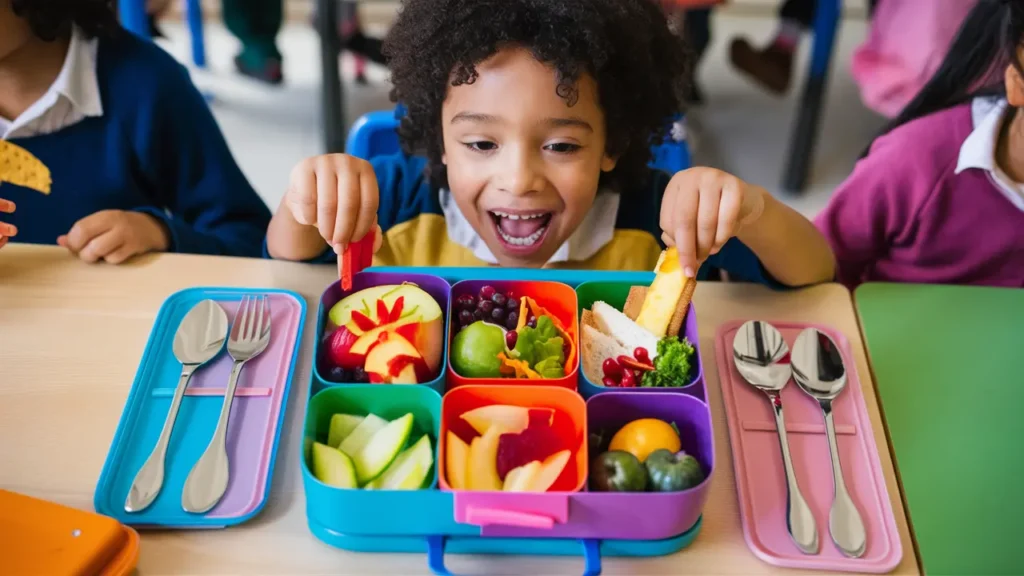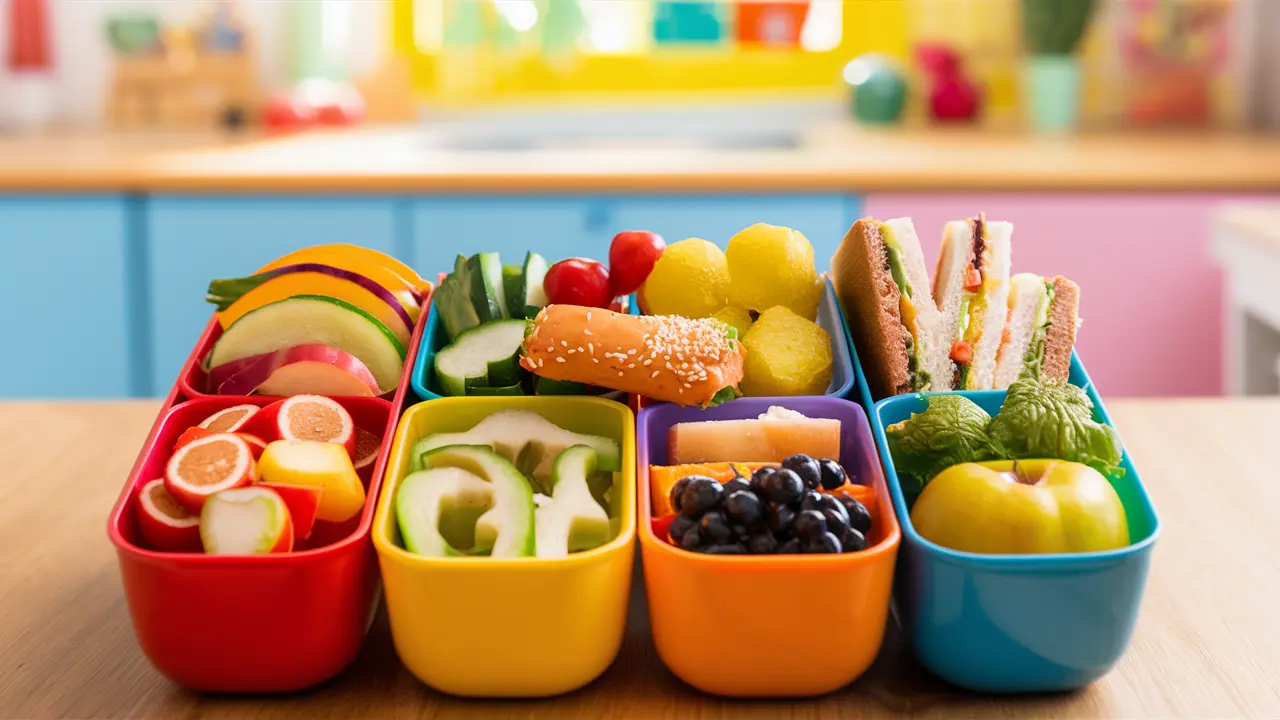Ah, the daily battle of packing a lunch box for your picky eater—talk about a real kitchen conundrum! Fear not, weary guardians; this article is brimming with creative lunch box ideas tailored specifically for those little discerning diners. From nutritiously balanced meals that don’t skimp on fun to strategies that invite your kids into the kitchen, we’ve got a treasure trove of tips to transform lunchtime into a much-anticipated break. Dive in, and let’s make those lunch boxes the envy of the cafeteria!
Part 1: Understanding Picky Eaters
Navigating the whims and fancies of picky eaters can feel like steering a ship through foggy waters. One minute they adore carrots, and the next, carrots are their sworn enemy! But don’t worry, it’s all part of their developmental journey. Let’s unpack some of these challenges and misconceptions to set the stage for culinary success.
Challenges Parents Face
If you’ve ever found yourself pleading with your child to just take one bite, you’re not alone. Picky eating can turn meal planning into an uphill battle. Many parents fret over their child’s nutrition, worrying whether they’re getting enough vitamins and minerals to fuel their growth and learning. This worry often doubles when preparing school lunches, since you’re not there to give a gentle nudge towards the vegetable sticks.
Common Misconceptions About Picky Eaters
First off, let’s debunk a big one: Picky eating isn’t just about disliking flavors. It’s often a whole dance involving textures, colors, and even temperatures. Also, contrary to popular belief, picky eating isn’t necessarily a stubborn refusal to try new things—it can be a normal phase of asserting independence. Understanding that this phase is, more often than not, temporary can be a huge relief!
In the midst of these challenges, it’s crucial to approach each meal with a dash of patience and a sprinkle of creativity. Remember, introducing kids to a variety of foods without pressure is the key to gradual, yet positive change. And honestly, isn’t it just a bit fascinating to watch their little personalities unfold, even if it’s over something as simple as a sandwich?
Part 2: Nutrition Fundamentals
Ensuring your child receives the right nutrients while catering to their selective taste can seem like a circus act. But with a little know-how and love, we can delight their taste buds and nourish their growing bodies.
Essential Nutrients for Growing Children
Growing kids need a robust mix of nutrients to help them stay active and engaged throughout the day. Proteins are crucial for building muscles and repairing tissues, while carbohydrates provide them the energy to run, play, and learn. Fats are not foes; they’re essential for brain health and energy. Let’s not forget about vitamins and minerals—calcium for strong bones, vitamin C for a healthy immune system, and iron for developing brains.
Incorporating a variety of these nutrients in your child’s lunch box isn’t just a boon for their health—it’s a buffer against the boredom of monotonous meals. Imagine a lunch box with colorful fruits, crunchy vegetables, various proteins, and a small treat. Not only does it cover the nutritional spectrum, but it also makes the meal visually appealing to kids.
Balancing Taste and Health
How do we make healthy foods appealing? Start by involving your child in the preparation process. When kids feel like they have a say in their meals, they’re more likely to eat them. Introduce new flavors gradually and pair them with familiar favorites. A slice of turkey might be more welcoming if it’s rolled around a stick of their favorite cheese, and a few spinach leaves can hide quite well in a berry smoothie.
Here’s another tip: make food fun! Who could resist nibbling on a sandwich cut into the shape of their favorite animal or assembling their own mini fruit kabobs? Encouraging playful interactions with wholesome foods can make all the difference.
Let’s not kid ourselves, though—this isn’t always a picnic. Some days, you’ll hit the jackpot, and other days, the lunch box might come back barely touched. That’s okay. Every meal is a stepping stone to developing a healthy relationship with food, and sometimes, those stones are just a bit slippery!
Part 3: Creative Lunch Box Ideas
Breaking out of the lunchtime rut requires a bit of imagination—think less along the lines of « just another sandwich » and more about engaging, playful meals that invite curiosity and delight. Let’s dive into some fun and creative ways to pack a lunch box that even the pickiest eaters can’t resist.
Theme-Based Lunch Boxes
A great way to pique your child’s interest is to theme their lunches around stories or adventures. This not only makes mealtime fun but also gives them something to look forward to. Here are a couple of ideas:
- Fun with Shapes and Colors: Use cookie cutters to create sandwiches, cheeses, and fruits in various shapes like stars, hearts, or animals. Add a rainbow of colors with different fruits and veggies to catch their eye and entice their taste buds.
- Adventure and Story-Themed Meals: If they’re into pirates, how about a treasure chest box filled with gold coin-shaped sandwiches, a small bag of « jewel » berries, and some « pirate ship » sliced bell peppers?
These themed lunches do more than feed your child; they spark their imagination and turn lunchtime into an adventure.
Finger Foods for Ease and Fun
Finger foods are perfect for little hands and can make eating a more interactive and less daunting task. Here are some finger food ideas that are easy to prepare and fun to eat:
- Easy-to-Eat Vegetables and Dips: Carrot sticks, cucumber, and bell pepper strips with a small container of hummus or yogurt dip can make veggies much more appealing.
- Variety of Mini Sandwiches and Wraps: Small pita pockets filled with a variety of fillings like chicken salad, veggie cream cheese, or even peanut butter and banana provide a good mix of nutrients and flavors that keep lunch interesting.
DIY Lunch Components
Giving kids the opportunity to assemble their own meals at lunch can be a game-changer. Here are some DIY ideas:
- Build-Your-Own Tacos or Pizzas: Pack separate containers of taco fillings or pizza toppings like shredded cheese, chopped veggies, and proteins. They’ll love the creativity of making their own mini tacos or pizzas.
- Mix-and-Match Salad Bowls: A base of lettuce or spinach, with compartments of various toppings like nuts, dried fruits, cheese cubes, and a light dressing, can engage them in making their own salad combinations.
By turning lunch into a creative activity, you’re not just packing nutrients into your child’s day—you’re also building their enthusiasm for wholesome foods and their confidence in making healthy choices.
Part 4: Recipes and Preparation
Now that we’ve sparked some creativity, let’s get into the nuts and bolts of actually preparing these imaginative lunches. Here are some quick, easy recipes and tips for meal prep that will streamline your mornings and ensure that your child is excited about their lunch every day.
Quick and Easy Recipes
Time is often of the essence on busy mornings. Here are five simple recipes that are quick to assemble and are sure to be hit with your picky eaters:
- Turkey and Cheese Roll-Ups: Skip the bread and roll slices of turkey around sticks of cheese. Add a little lettuce for crunch and wrap them with a thin strip of cucumber for added veggies.
- Fruit and Yogurt Parfaits: Layer yogurt with berries and a sprinkle of granola in a small container. It’s like having dessert for lunch!
- Mini Rice Balls: Mix cooked rice with a bit of cooked chicken and peas, shape into balls, and wrap them in nori for a fun and filling meal.
- Veggie Muffins: Incorporate grated zucchini and carrots into a basic muffin batter for a sweet treat that packs in the nutrition.
- Pasta Salad: Toss cooked pasta with cherry tomatoes, diced mozzarella, and a drizzle of pesto for a refreshing and satisfying lunch option.
Each of these recipes can be made in advance, ensuring that your mornings are as smooth as possible.
Meal Prep Strategies
Preparing ahead of time is key to managing morning madness and ensuring that your child has a healthy, homemade lunch. Here are some tips to make meal prep a breeze:
- Weekly Meal Planning: Dedicate a little time each weekend to planning out the week’s lunches. This can help reduce daily stress and prevent last-minute unhealthy choices.
- Storage and Packing Solutions: Invest in good-quality, compartmentalized lunch containers that keep foods separate and fresh. Having the right tools can make all the difference in how appealing the lunch looks when it’s time to eat.
- Batch Cooking: Cook larger quantities of versatile ingredients like chicken, rice, or pasta on the weekend. These can be used in various ways throughout the week to save time and energy.
By organizing your approach and involving your children in the preparation process, you can not only make healthier choices but also foster a sense of responsibility and independence in your little ones. Together, you’ll discover that even the pickiest eater can become an adventurous foodie with just a little encouragement and creativity.
Part 5: Addressing Common Issues
Even the most creatively packed lunch boxes can sometimes face hurdles, from untouched leftovers to dietary restrictions. Let’s explore some common issues and provide practical solutions to ensure your child enjoys a healthy and enjoyable lunch every school day.
Dealing with Leftovers
It can be disheartening to see the lunch you lovingly prepared come home untouched. Here’s how you can manage this challenge:
- Encouraging kids to finish their lunch: Sometimes, children need a little motivation. Engage in a conversation about what they like and don’t like, and adjust the portions accordingly. Smaller, more manageable portions might encourage them to eat more. Also, involving them in the packing process can make them more likely to eat their lunch, as they feel a sense of ownership over their meal choices.
Allergies and Dietary Restrictions
Navigating food allergies or dietary restrictions can add an extra layer of challenge to preparing a school lunch. Here are some tips for accommodating these needs:
- Gluten-Free and Dairy-Free Options: For children who need to avoid gluten, focus on naturally gluten-free foods like rice, potatoes, and corn. Use gluten-free bread or wraps for sandwiches. For dairy-free diets, substitute regular cheese and yogurt with soy or almond alternatives. Always check labels to ensure that packaged goods are free of hidden allergens.
By addressing these common lunchtime issues, you can help ensure that your child’s lunch box comes back empty for all the right reasons. Remember, the goal is to make mealtime enjoyable and stress-free for both you and your child.
Part 6: Engaging Your Child

One of the most effective strategies to encourage picky eaters to embrace a variety of foods is to involve them in the meal planning and preparation process. This engagement not only makes them more likely to eat what they’ve helped prepare but also provides valuable learning opportunities.
Involving Kids in Meal Planning
Getting your children involved in the meal planning process can turn lunchtime into an exciting event that they look forward to. Here’s how you can do it:
- Let them pick one item to include in their lunch each week, whether it’s a favorite fruit, a type of sandwich, or a snack. This choice gives them a sense of control and anticipation.
- Use meal planning as an opportunity to teach about nutrition. Explain why it’s important to have a mix of proteins, fats, and carbohydrates, and let them help in balancing their meal components.
Educational Opportunities
Mealtime is a perfect opportunity to educate your children about food and health. Here are some ways to make education fun and engaging:
- Discuss where foods come from, exploring different cultures’ cuisines and the origins of various ingredients.
- Teach them about the importance of colors on their plate, explaining how different colored foods can help different parts of their body.
By integrating these educational elements into meal planning and preparation, you’re not only helping your child develop a healthy relationship with food but also enhancing their knowledge and appreciation of nutrition. This can lead to better eating habits and a greater willingness to try new foods, ultimately enriching their diet and culinary curiosity.
Part 7: FAQs
Addressing frequently asked questions can help clarify common concerns and offer quick tips for parents dealing with the everyday challenges of feeding picky eaters. Here are some of the most common questions and their answers:
Protein Choices for Picky Eaters
What are some protein-rich foods for picky eaters? For picky eaters, it’s important to incorporate protein in forms that are not just nutritious but also appealing. Think beyond plain meat and consider alternatives like yogurt, cheese, eggs, and nut butters. These can be introduced in various fun and tasty formats, such as smoothies, dips, or spreads on crackers or fruit slices.
Ensuring Nutritional Adequacy
How can I ensure my child gets enough nutrients? Variety is key. Try to include a range of foods in your child’s diet to cover the spectrum of necessary nutrients. Incorporate different fruits, vegetables, proteins, and grains throughout the week. If you’re concerned about any nutritional gaps, consider speaking with a pediatrician who might recommend supplements.
Last-Minute Lunch Fixes
What are some quick lunch box fixes for last-minute preparations? Keep some healthy staples on hand that don’t require much preparation, like whole fruits, pre-cut veggies, yogurt, cheese sticks, and whole-grain crackers. These can quickly be thrown together in a lunch box when you’re short on time.
Making Vegetables Appealing
How do I make vegetables appealing to my child? Presentation can make all the difference. Try serving vegetables with a favorite dip or sauce, cutting them into fun shapes with cookie cutters, or mixing them into familiar dishes like pasta sauces or pizza toppings.
Dairy-Free Alternatives
What are some good dairy-free substitutes for common lunch items? For dairy-free diets, there are several alternatives that can be used in lunches, such as almond, soy, or oat milks, and cheese alternatives made from nuts or soy. Look for dairy-free yogurts and ice cream as treats too.
These FAQs provide a quick reference for tackling the everyday issues faced by parents of picky eaters, giving them confidence and new ideas to ensure their children enjoy healthy, varied diets.
Part 8: Conclusion
Navigating the culinary preferences of picky eaters can sometimes feel like a high-wire act, balancing nutrition, variety, and appeal. Yet, with a little creativity, persistence, and involvement, you can transform mealtime. It changes from a battlefield into a delightful exploration of tastes and textures. Remember, every small step is progress—a nibble here, a snack there, it all adds up to broader dietary horizons.

Encourage your child’s curiosity about food by making lunch colorful, fun, and interactive. Include them in the process, from picking ingredients at the store to assembling their meals. This fosters a sense of ownership and accomplishment. Celebrate their willingness to try new things, no matter how small the effort may seem. Over time, these positive experiences can diminish the frustrations associated with picky eating.
Lastly, don’t hesitate to reach out for help if you’re concerned about your child’s nutrition. Pediatricians and nutritionists can offer valuable guidance and reassurance. They ensure your child receives the necessary nutrients to grow healthy and strong. Each imaginative lunch box you prepare does more than feed your child for a day. You’re teaching them eating habits that can last a lifetime.
In conclusion, while the journey with a picky eater can be challenging, it’s also incredibly rewarding. Watching your child slowly but surely expand their palate is a testament to your dedication and creativity. So, keep up the great work, stay patient, and keep those innovative lunch boxes coming!
